K-Content News
- January 08, 2025 | Broadcasting/Other
How K-Content Led K-Ramen to Success
Last year, Korea ushered in a new milestone by reaching 1 trillion won in ramen exports. According to the Ministry of Agriculture, Food and Rural Affairs, ramen exports through April increased by 34.4% compared to the same period last year. K-content played a significant role in establishing ramen the flagship of K-food by introducing it to the world.
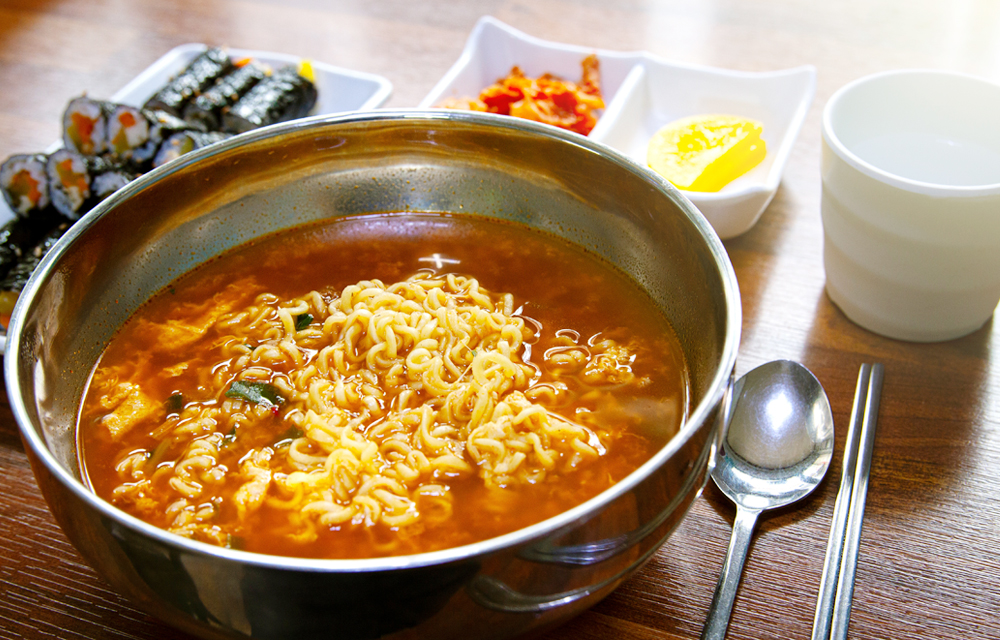
©Shutterstock
K-Ramen's Appearance in K-pop Stars' Daily Lives
Ramen often makes an appearance in the social media videos of K-pop stars like BTS and BLACKPINK, accompanying unscripted moments of their daily lives. Ramen serves as a device that adds K-pop stars' down-to-earth charm. As ramen repeatedly appeared in K-pop stars' daily vlogs, global fans began to take notice. Here is how this cultural phenomenon typically unfolds: Fans learn that BTS member Jimin's favorite is "Buldak Bokkeum Myeon" (Hot Chicken Flavor Ramen). People become curious about the taste of the ramen that Jimin enjoys. Soon, fans eager to emulate Jimin's experience begin trying Buldak Bokkeum Myeon themselves. More people begin sharing their "mukbang" videos on social media, featuring the ramen favored by K-pop stars. Through this organic and cyclical process, K-ramen gained widespread recognition and popularity in the global market.
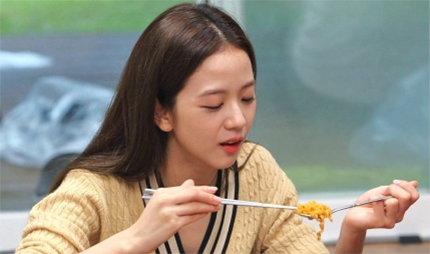
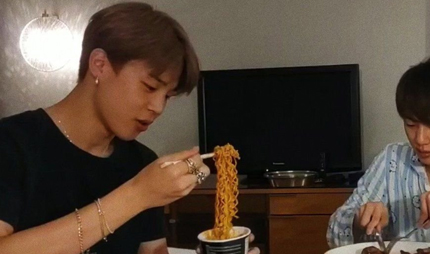
BLACKPINK's Jisoo eating ramen
| Photo: SBS "Delicious Rendezvous”
BTS Jimin eating Buldak Bokkeum Myeon
| Photo: BTS YouTube video
K-Ramen Embodying Korea's Universal Appeal
Dramas and films have also contributed to ramen's global popularization. The 2019 film "Parasite," which swept awards including Best Picture and Best Director at the Cannes Film Festival and the Academy Awards, sparked a global "chapaguri" (Chapaghetti + Neoguri) craze. Ramen also appears in "Squid Game," the Netflix drama watched by over 140 million households since its 2021 release. This time it was uncooked ramen. The scene of eating uncooked ramen as a drinking snack at a convenience store table captured global viewers' attention.
Why does ramen appear so frequently in popular culture? Above all, ramen is deeply intertwined with Koreans' daily lives. It is affordable, easy and quick to make, and universally loved for its taste. Ramen holds a unique universal charm. Including ramen in a story makes extraordinary people feel approachable and adds sympathy to seemingly cold characters. It is a versatile device for giving characters more depth and layers or embedding metaphors in stories. "Would you like to have some ramen?" In Korea, few people take this phrase at face value. It is often understood as a euphemism for "the start of love" or "taking a relationship to the next level." This line from the 2001 film "One Fine Spring Day," has evolved over the past 20 years to become a well-known idiom.
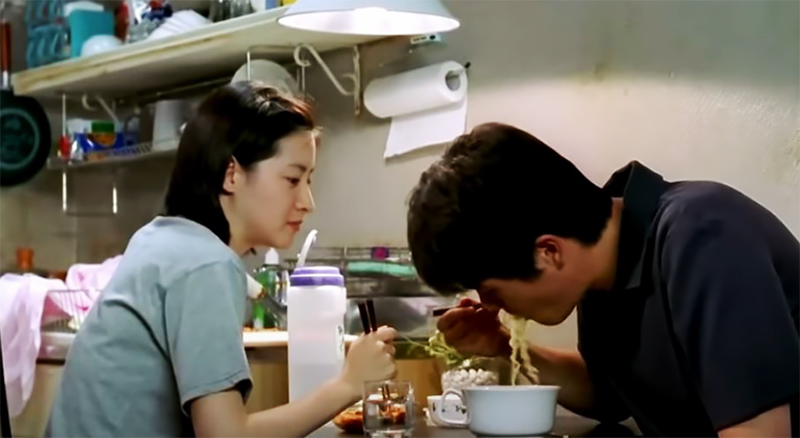
Film "One Fine Spring Day" ©Cinema Service
K-Ramen, Present in All K-Content
Ramen can trigger associations like this: "Chapaghetti, Neoguri, and premium sirloin." A scene from "Parasite" brought these three together in the minds of viewers. The scene where the protagonist Yeon-gyo (Cho Yeo-jeong) eats black bean ramen made with Chapaghetti and Neoguri topped with sirloin steak left a deep impression on viewers as a metaphor.
Ramen appears not only in blockbuster hits. It is a staple of K-content, appearing everywhere in Korean dramas, webtoons, and films. As Korean dramas and movies gain popularity on global OTT platforms like Netflix and Disney Plus, works featuring ramen are being consumed more frequently on a broader scale.
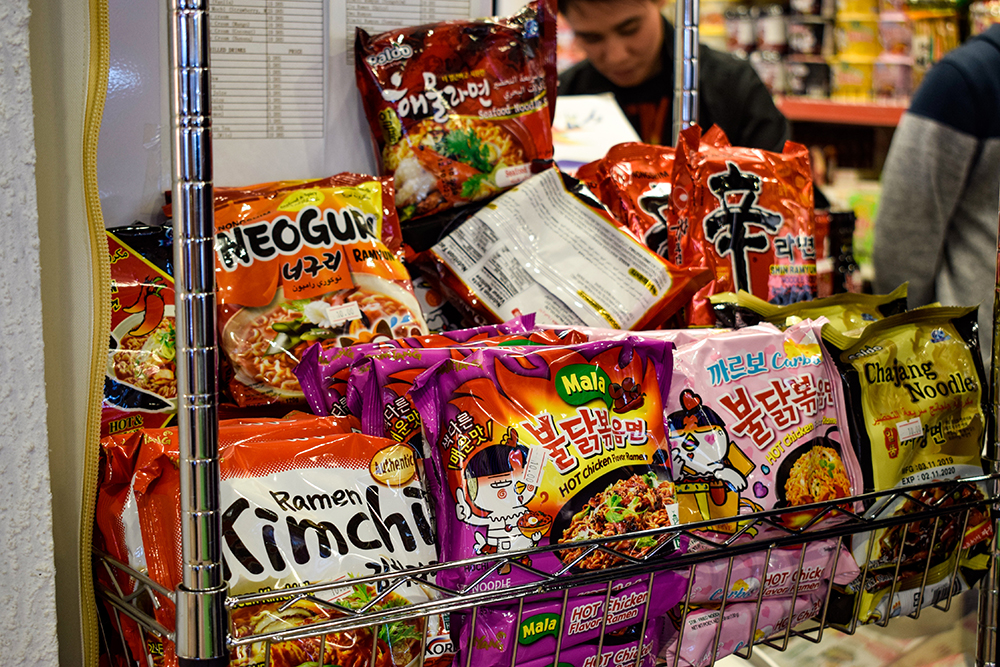
©Shutterstock
Ramen's presence is not confined to tightly scripted content. For ordinary people, ramen often becomes a topic of conversation. How many people do not have at least one memorable moment involving ramen? This universal connection is why ramen often transcends its role as a simple meal. It serves as a medium to create metaphors, stimulates imagination, crafts stories, and resonates with many individuals.
The Various Iterations of "Ramen Mukbang"
Ramen, which serves as a medium for sharing universal emotions, can also become independent content. It provides the material to create unique and differentiated concepts. People can create their own recipes and make unique dishes through various interpretations. K-ramen is consumed as diverse content by highlighting these distinctions. Even now, social media is flooded with ramen-related videos. Videos sharing spicy challenges, large portion mukbangs, proper ramen cooking methods, and popular ramen taste comparisons are widely shared. Through ramen challenge and taste comparison videos by both Koreans and foreigners, we can gauge K-ramen's current standing in the global market.

Various ramen mukbang screens


Foreign YouTubers' ramen mukbang screens
Growing Global Interest in K-Ramen
Samyang Food's "Buldak Bokkeum Myeon" is a prime example of a ramen brand that has established itself as content on social media. Launched in 2012, Buldak Bokkeum Myeon performs better overseas than domestically, with its global popularity kickstarted on YouTube. The "Buldak Challenge" became trendy when YouTubers known as "Korean Englishman" attempted the spicy ramen challenge, sparking a lasting trend. Last year's "Play Buldak" dance challenge on YouTube garnered hot responses with total video views of 700 million and 50,000 challenge participants. Recently, "Carbonara Buldak Bokkeum Myeon" has become a hot item that's frequently sold out in the United States. A video of famous rapper Cardi B and TikToker Keith Lee (with 16.1 million followers) driving 30 minutes to buy and cook Carbonara Buldak Bokkeum Myeon has surpassed 57.7 million views. A video of an American girl delighted to receive Carbonara Buldak Bokkeum Myeon as a birthday gift recorded over 100 million combined views across TikTok, Instagram Reels, and YouTube Shorts. It also made headlines when Samyang Foods gifted approximately 1,000 Carbonara Buldak Bokkeum Myeon packages to the young fan.


Adalyn Sophia, known as a 'Carbo Buldak' fan
Photo | TikTok capture
K-Ramen Growing as Independent Content
Nongshim's ramen export history dates back to 1996. After steady growth, its export performance entered a rapid growth phase in the mid-2010s, coinciding with the rising popularity of K-content. Centered on its flagship brand "Shin Ramyun," Nongshim achieved overseas sales of $1 billion in 2020. Last year, it recorded its highest-ever sales of $1.3 billion. Shin Ramyun, along with "Chapaghetti" and "Neoguri," raised its awareness through K-content and continues to expand through social media. A video from the popular American YouTube channel "Good Mythical Morning," with 18.6 million subscribers, searching for the best ramen, has been a longstanding topic of interest. The video, which recently surpassed 6.2 million views and garnered over 7,000 comments, ranked Nongshim's Shin Ramyun as number one.
Ramen has grown alongside K-content, creating a powerful synergy, and is now being utilized as independent content. K-ramen isn't the only K-food creating synergy with K-content. Kimbap, chicken, and tteokbokki are also expanding globally. The success story of K-ramen in tandem with K-content is expected to positively influence other K-foods as well.
Written by Moon Su-jung (Kookmin Ilbo Reporter)
Original Article URL: https://www.kocca.kr/n_content/kocca_vol31/vol31/09.html
